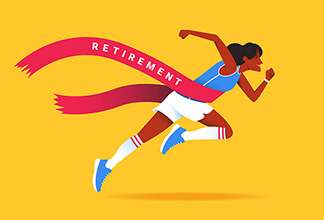Talk to Your Teen About Money: 5 Foolproof Conversation Starters
Written by Tamar Satov
Published on July 2, 2019
minute read
Share:
Just because school has wrapped for the year doesn't mean your kids can't keep on learning. Indeed, the lazy days of summer present a perfect opportunity for parents to sneak in some valuable lessons for tweens and teens about important topics. The trick, of course, is to broach the subject in a way that doesn't feel forced or scream "teachable moment" from a mile away.
Here are five ideas to spark age-appropriate conversations with your kids about investing, without being met with the dreaded eye-roll.
- Ask about their favourite brands. Whether it's a popular athletic shoe, fast food chain or beloved tech provider, chances are your kids are passionate about one brand or another whose parent company may very well trade on a stock exchange. Find out if they knew they could one day own a slice of that company (and share in its profits or losses); then use that as a jumping off point to explain the difference between privately held and publicly owned businesses. If you get traction on that, maybe encourage them to look up the stock symbol for the company, and check out its trading price.
- Use that brand to illustrate the concept of inflation. Do a little research to find out how much their favourite burger, pair of shoes or other product cost when you were their age, as compared to now. Make it fun by asking them to guess the difference in price. You could then explain that prices tend to go up over time due to inflation and, because of this, the purchasing power of savings can be eroded over time — which is one of the reasons why investing and earning money on your savings can be a smart thing to do.
- Get them to guess how much they think $100 invested today would be worth in 100 years, with compound earnings of 10 per cent per year and an annual rate of inflation of 2 per cent. In his book Millionaire Teacher: The Nine Rules of Wealth You Should Have Learned in School, Andrew Hallam shows the power of compounding with this exact example. In 100 years, that $100 would be worth well over $1.3 million. If your kids don't believe you, show them how to use an online investment calculator — such as the one offered by the Bank of Canada — that will crunch the numbers for them.
- Ask what they'd do if you gave them a choice between investing $1,000 in their beloved brand, or putting $1,000 into an investment with a guaranteed rate of return, like a guaranteed investment certificate (GIC). This can be a great way to introduce the idea of risk and time horizons. For example, if they plan to use their hypothetical windfall to help pay for university — which may only a year or two away — what would that mean for their investment if the company had a bad year? It's an important lesson to learn that investing can result in losses as well as gains.
- Let them see for themselves by setting up a practice account. If your teens seem particularly receptive to this line of discussion, maybe suggest a practice account, which would allow them to choose investments and track their performance over time without taking on any risk.
This article was updated on July 16, 2019.
RBC Direct Investing Inc. and Royal Bank of Canada are separate corporate entities which are affiliated. RBC Direct Investing Inc. is a wholly owned subsidiary of Royal Bank of Canada and is a Member of the Canadian Investment Regulatory Organization and the Canadian Investor Protection Fund. Royal Bank of Canada and certain of its issuers are related to RBC Direct Investing Inc. RBC Direct Investing Inc. does not provide investment advice or recommendations regarding the purchase or sale of any securities. Investors are responsible for their own investment decisions. RBC Direct Investing is a business name used by RBC Direct Investing Inc. ® / ™ Trademark(s) of Royal Bank of Canada. RBC and Royal Bank are registered trademarks of Royal Bank of Canada. Used under licence.
© Royal Bank of Canada 2025.
Any information, opinions or views provided in this document, including hyperlinks to the RBC Direct Investing Inc. website or the websites of its affiliates or third parties, are for your general information only, and are not intended to provide legal, investment, financial, accounting, tax or other professional advice. While information presented is believed to be factual and current, its accuracy is not guaranteed and it should not be regarded as a complete analysis of the subjects discussed. All expressions of opinion reflect the judgment of the author(s) as of the date of publication and are subject to change. No endorsement of any third parties or their advice, opinions, information, products or services is expressly given or implied by RBC Direct Investing Inc. or its affiliates. You should consult with your advisor before taking any action based upon the information contained in this document.
Furthermore, the products, services and securities referred to in this publication are only available in Canada and other jurisdictions where they may be legally offered for sale. Information available on the RBC Direct Investing website is intended for access by residents of Canada only, and should not be accessed from any jurisdiction outside Canada.
Explore More

Should I Invest or Pay Down My Mortgage?
Consider these four questions
minute read

As Many Head Back to the Office, Where Could Investors See Changes?
How returning to in-person work could affect a range of investments
minute read

Considering the FIRE Lifestyle? Here’s What Your Investments Might Look Like
We asked three people how they created financial independence and retired early
minute read
Inspired Investor brings you personal stories, timely information and expert insights to empower your investment decisions. Visit About Us to find out more.







